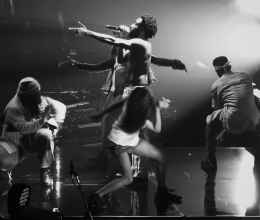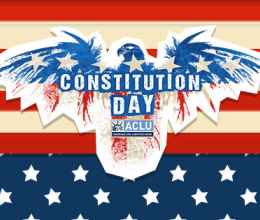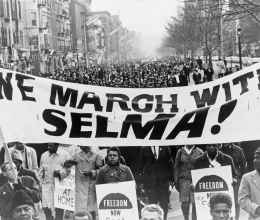
May is Asian Pacific American Heritage Month (APAHM), which officially started as a week long celebration in 1978. May was chosen to commemorate the anniversaries of the first Japanese immigrants coming to the United States and of the completion of the transcontinental railroad, which was mostly built by Chinese immigrants. Asian and Pacific American representation has frequently been overlooked in politics, media, school curriculums, and more, meaning much of this history is unknown by many even though there have been many important and influential APIA icons who deserve recognition. So here's a starter on six Asian and Pacific Americans that every person should know about. Who's your favorite Asian icon?
1. Yuri Kochiyama
Known for holding Malcolm X in her arms after his assassination, Yuri Kochiyama became interested in social justice after she and her family were held in Japanese internment camps during World War II. She was an advocate for a range of social justice movements, including the South African anti-apartheid movement, black nationalism, and Puerto Rican independence. After meeting Malcolm X at a protest in Brooklyn, Yuri Kochiyama joined his Organization of African American Unity and frequently attended meetings. In 1988, she, along with other groups, fought U.S. Congress to pass the Civil Liberties Act, granting each survivor of the Japanese internment survivors $20,000 in reparations. This victory encouraged Yuri Kochiyama to fight for reparations for African Americans. Later, she advocated for fair treatment of Muslims, Middle Easterners, and South Asians in the United States, considering the profiling and bigotry as an experience similar to that of Japanese Americans during the second world war.
2. Richard Aoki
Richard Aoki is probably most notable for leading the Third World Liberation Front Strike at University of California, Berkeley, which lead to the creation of the Department of Ethnic Studies. Born to Japanese parents in San Leonardo, California, he moved to Oakland after World War II, joined a gang, and still became the valedictorian at his high school. He was a civil rights activist and became an early member of the Black Panther Party in 1967, one year after its creation. When police brutality increased in Oakland, Richard Aoki supplied the Black Panthers with firearms to defend themselves and their communities. He was an active member of several organizations, including the Vietnam Day Committee and the Oakland-Berkley branch of the Socialist Workers Party. Through his association with these groups and his activism, Richard Aoki became an anti-war advocate and frequently participated in anti-war activism.
3. Helen Zia
Chinese American journalist and activist, Helen Zia, rose to prominence after seeking justice for the brutal and racially charged murder of Vincent Chin. By writing about Chin’s story and by cofounding the American Citizens for Justice organization, Helen Zia was able to push for a retrial of Chin’s case that reclassified it as a civil rights case. Helen Zia was also known for her activism. She wrote about many issues, including the difficulties of immigrants and second-generation immigrants in the United States and sexual assault on college campuses. Her work led to overhauls of campus policies in the University of Michigan. Helen Zia also aided in a court case that would legalize gay marriage in California. She served as an expert witness in the Hollingsworth v. Perry Supreme Court case. She later married her long-time partner, Lia Shigemura—her marriage one of the first same-sex marriages in the state of California.
4. Iqbal Ahmad
One of Pakistan’s most memorable journalists, Iqbal Ahmad, sought to reveal world-wide injustices. Examples of social justice groups he advocated for include the Algerian National Liberation Front, Palestinian rights groups, and the Washington Institute of Policy Studies. An anti-war activist, Iqbal Ahmad often voiced his distaste for the Vietnam War. His views resulted in his indictment for planning to capture Henry Kissinger, the National Security Advisor. His case resulted in a mistrial and Iqbal Ahmad was acquitted of all charges. After his death, the Eqbal Ahmad Center for Public Education was named to honor Iqbal Ahmad’s work.
5. Patsy Mink
Third generation Japanese American, Patsy Mink, was the first Asian American woman elected to the United States Congress. Her rise to power was difficult; though she had a degree in law, she was unable to find work because of her status as a married Asian American woman. Before she was elected to Congress, Patsy Mink was elected to represent her district in Hawaii’s territorial House of Representatives. Two years later, she was elected to the territorial senate. In 1964, Patsy Mink was elected to represent Hawaii’s Second Congressional District—one of eight women in Congress serving during that time. Her most notable achievement is Title IX, a legislation that prohibits gender discrimination in education.
6. Larry Itliong
Filipino American, Larry Itliong, was a labor organizer and an activist that advocated for the fair treatment of the working class. In 1965, he helped lead the first Delano Grape Strike, a strike aiming to protest the awful conditions of grape pickers in California’s Coachella Valley. The strike was successful in raising the wages. After his success, Larry Itliong joined labor leaders and civil rights activists Cesar Chavez and Dolores Huerta, in the establishment of the United Farm Workers, a labor union for American farm workers. Along with advocating for higher wages for farm workers, Larry Itliong served an essential role in bridging the divide between Chicano and Filipino laborers. October 25th is now celebrated as Larry Itliong day in California.
Photo: "Solidarity" by Marcela on Flickr, licensed under CC 2.0


